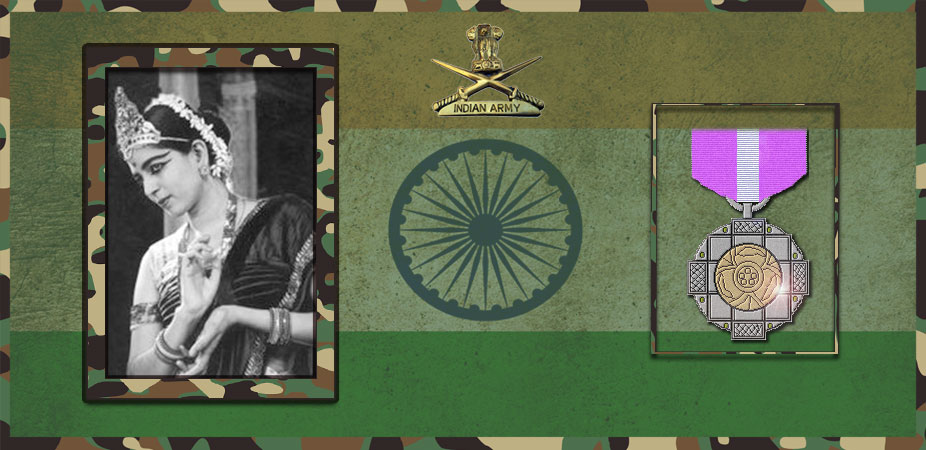Let's salute to our Indian Army together, We are proud to be Indian.
Let's salute to our Indian Army together, We are proud to be Indian.

Rukmini Devi Arundale (29 February 1904 – 24 February 1986) was an Indian theosophist, dancer and choreographer of the Indian classical dance form of Bharatanatyam, and an activist for animal rights and welfare.
She also is the first ever woman in Indian History to be nominated as the Rajya Sabha member. She is considered the most important revivalist in the Indian classical dance form of Bharatanatyam from its original ‘sadhir’ style, prevalent amongst the temple dancers, Devadasis, she also worked for the re-establishment of traditional Indian arts and crafts.
Though she belonged to the Indian upper-caste she espoused the cause of Bharata Natyam, which was considered a low and vulgar art in the early 1920s. Recognising the beauty and the spiritual value of this art form, she not only learned the dance, but also presented it on stage despite strong public protests.
Rukmini Devi features in India Todays list of ‘100 People Who Shaped India’. She was awarded the Padma Bhushan in 1956, and Sangeet Natak Akademi Fellowship in 1967.
In 1933, at the Annual Conference of Madras Music Academy, she saw for the first time, a performance of the dance form called Sadhir.Later she learnt the dance from ‘Mylapore Gowri Amma’, and finally with help of E Krishna Iyer from ‘Pandanallur Meenakshi Sundaram Pillai’. In 1935, Rukmini Devi gave her first public performance at the ‘Diamond Jubilee Convention of the Theosophical Society.
In January 1936, she along with her husband,established Kalakshetra, an academy of dance and music, built around the ancient Indian Gurukul system, at Adyar, near Chennai. Today the academy is a deemed university under the Kalakshetra Foundation and is situated in its new in 100-acre (0.40 km) campus in Tiruvanmiyur, Chennai, where it shifted, in 1962. Amongst its noted students are Radha Burnier, Sarada Hoffman, Anjali Mehr, Kamaladevi Chattopadhyay, Sanjukta Panigrahi, C V Chandrasekhar, Yamini Krishnamurthy and Leela Samson.
Originally known as sadhir, the Indian classical dance form of Bharatanatyam owes its current name, to E Krishna Iyer and Rukmini Devi Arundale, who has been instrumental in modifying mainly the Pandanallur style of Bharatanatyam and bringing it to the global attention, and removing the extraneous sringaar and erotic elements from the dance, which were the legacy of its Devadasi association in the past.Soon she changed the very face of the dance, by introducing musical instruments, like violin, set and lighting design elements, and innovative costumes, and jewellery inspired by the temple sculptures.Just as for her teacher she approached noted gurus in various arts and classical dances, for her productions, Rukmini Devi approached noted scholars for inspiration and classical musicians and artists, for collaboration, the result was the creation some of pioneering dance dramas-based on Indian epics like the Valmiki’s Ramayana and Jayadevas Gita Govinda. Starting with famous dance dramas like, ‘Sita Swayamvaram’, ‘Sri Rama Vanagamanam’, ‘Paduka Pattabhishekam’ and ‘Sabari Moksham’, followed by ‘Kutrala Kuruvanji’, ‘Ramayana’, ‘Kumara Sambhavam’, ‘Gita Govindam’ and ‘Usha Parinayam’.
Schools based on the Montessori method were first started in India,when Dr George Arundale invited Dr Maria Montessori to start courses in the ‘Besant Theosophical High School’ in 1939, and later also established, the ‘Besant Arundale Senior Secondary School’, The College of Fine Arts, The Besant Theosophical High School, The Maria Montessori School for Children, The Craft Education and Research Centre and the U V Swaminatha Iyer Library, within the Kalakshetra campus.
Rukmini Devi was nominated as a member of the Indian Parliament’s Council of States (the Rajya Sabha) in April 1952, and re-nominated in 1956.She was the first Indian woman to be nominated in Rajya Sabha. Keenly interested in animal welfare, she was associated with various humanitarian organisations, and as a member of the Rajya Sabha, was instrumental for the legislation for the Prevention of Cruelty to Animals Act and for later setting up of the Animal Welfare Board of India, under her chairmanship in 1962. She remained on the board until her demise in 1986.
She was a strict vegetarian and did much work to promote vegetarianism in the country. She was Vice-President of International Vegetarian Union for 31 years from 1955, until her death.
In 1977, Morarji Desai offered to nominate her for the post of President of India, which she turned down.In 1978, ‘Kalamkari Centre’ (pencraft) was set up at Kalakshetra to revitalise the ancient Indian craft of textile printing. Rukmini Devi Arundale died on 24 February 1986 in Chennai.